Before, when asked about her hometown, Leila Wu, a 19-year-old college sophomore, would preface it by saying “near Alhambra” or “near Pasadena.”
Now, she doesn’t think that will be necessary. “Whenever I tell people I’m from Monterey Park from now on, all they’re going to remember is the shooting,” says Wu, a lifelong resident of the city who described “that community and that safety” as “kind of destroyed.”
The Monterey Park community is still reeling from the January 21 mass murder of eleven people at Star Ballroom Dance Studio. The victims were Ming Wei Ma, one of the studio’s managers; Mymy Nhan, who joined the ancestors she had paid homage to earlier that day; Diana Man Ling Tom, who loved dance; Xiujuan Yu, a hardworking mother of three; Valentino Marcos Alvero, the life of the party; Yu Lun Kao, a contractor in construction; Hongying Jian, a volleyball enthusiast; Wen Tau Yu, a pharmacy student; Chia Ling Yau, who enjoyed music, dance, and travel; Muoi Dai Ung, a refugee from Vietnam; and LiLan Li, described as “a pillar of strength and optimism.”
While police officers responded within a few minutes, the shooter fled the scene, showing up armed to a dance studio in neighboring Alhambra about 17 minutes later. There, he was disarmed by 26-year-old Brandon Tsay, whose family has operated that dance hall for three generations.
The shooter fled again, evading authorities for over 12 hours before dying of a self-inflicted gunshot wound. Wu heard police sirens going by her house all night. She criticized the police response: “They didn’t tell anyone to stay home or to be safe. That was all [done by] our community.”
On that night, Jason Jem, a 67-year-old retired clinical psychologist, was out dancing too—just a few miles away from Star Ballroom Dance Studio, which he’d visited countless…
Read the full article here





